
La Earthcache / The Earthcache
Le phare du cap Béar ou phare de Béar est une tour pyramidale en roches apparentes d'une hauteur de 27 m le faisant culminer à une altitude de 80 m au-dessus du niveau de la mer.
Deux formations géologiques différentes en forment les parements externes.
► Le Granite, roche magmatique plutonique
~ Le granite, une roche QFM
Le granite provient de la cristallisation lente dans la croûte terrestre d'une magma liquide.
Cela donne une roche QFM de teinte claire avec une nature entièrement cristalline, une texture grenue (cristaux visibles à l’œil nu) et une composition chimique majoritaire basée sur 3 minéraux :
- Q comme Quartz (SiO2) : translucide parfois transparent, ce minéral est gris sans facette.
- F comme Feldspath : minéral opaque à translucide, blanchâtre ou rose (orthose) selon la présence d’oxydes de fer et souvent en macles (forme rectangulaire).
- M comme Mica : ce minéral se présente en fines paillettes brillantes selon deux formes :
- la biotite, mica noir brillant de composition ferromagnésienne.
- la muscovite, mica blanc brillant au soleil avec un aspect nacré.

~ Les Xénolithes
Un xénolithe est une enclave d'une roche incluse dans une roche différente.
Le magma acide crustal riche en silice (teinte claire) donne le granite sensu lato mais ce magma de la croûte peut arracher des fragments de magma mantellique basique (teinte sombre).
Cela donne des enclaves pluri-centimétriques au sein des granites, les xénolithes, qui se caractérisent par une teinte beaucoup plus sombre que le granite (roches riches en ferromagnésiens).
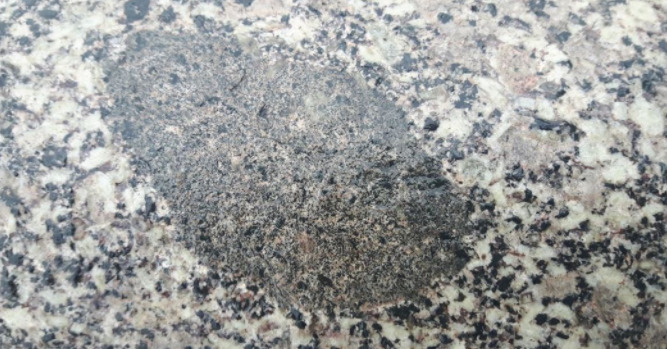
► Le Marbre de Villefranche de Conflent
A Villefranche de Conflent se trouve le marbre le plus caractéristique du Roussillon.
Issu de la métamorphisation de sédiments du Dévonien (-390 Ma), c'est une roche cristalline faite de calcite, dure, non grenue et avec plusieurs faciès.
~ Le faciès griotte
C'est un marbre rouge violacé à nodules fossilifères. Il se distingue par ses petites concrétions pierreuses appelées "yeux de perdrix".
Ces yeux sont les restes fossiles de goniatites, ancêtres des ammonites, se présentant en section comme des petits disques de couleur rouge cernés par un liseré sombre évoquant la cerise griotte.
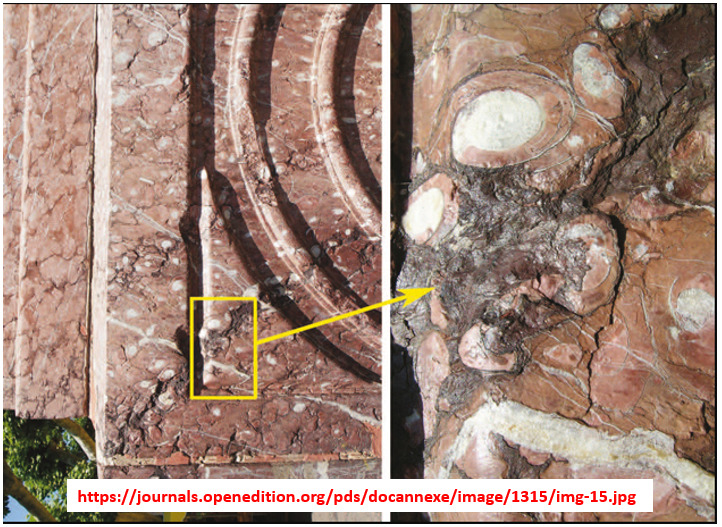
~ Le facies "fleurs de Pécher"
Il s’agit d'un calcaire marbrier noduleux sans fossile.
De tonalité plutôt pâle, il est formé d’amandes de calcite versicolores, roses à blanches, qui sont cloisonnées par des filets chloriteux bruns à verdâtres.
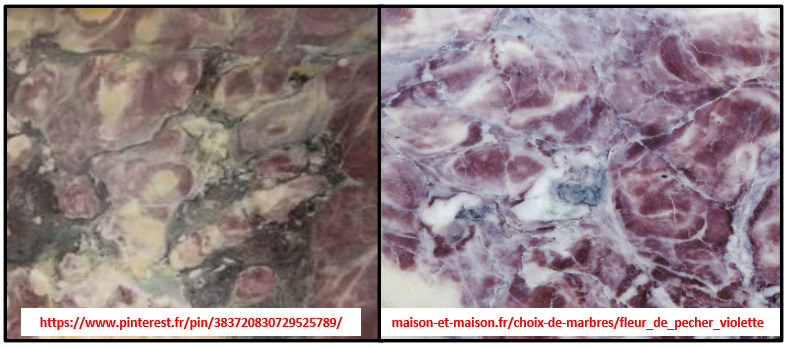
~ Le facies flammé
Mis en place à l'étage Givétien, c'est un calcaire marbrier de couleur rose ou rouge « flambé » ou « flammé » de blanc, sans trace de fossile.
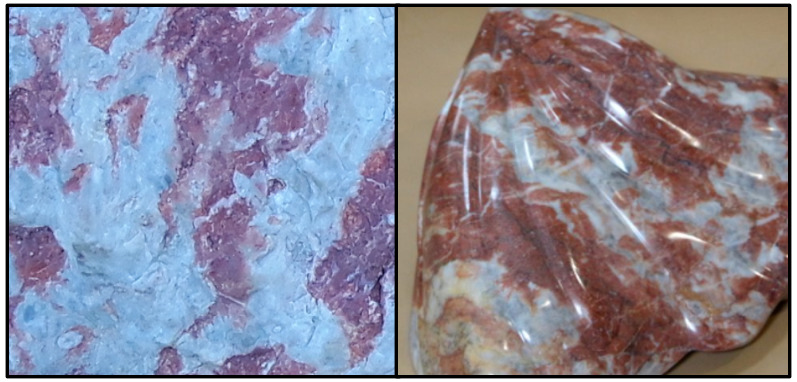
~ Les colorations du marbre
Initialement blanc, la calcite du marbre peut se colorer par la présence d'impuretés minérales.
Voici quelques éléments responsables de ces colorations :
- Le Fer : à faible concentration, il donne une couleur violette (améthyste), mais sous une forme plus concentrée et oxydée, donne une couleur rouge/rose au cristal ; on parle alors d'hématite.
- Le Chrome : il donne une coloration verte au minéral.
- Le Cobalt : il donne une couleur bleue au cristal.
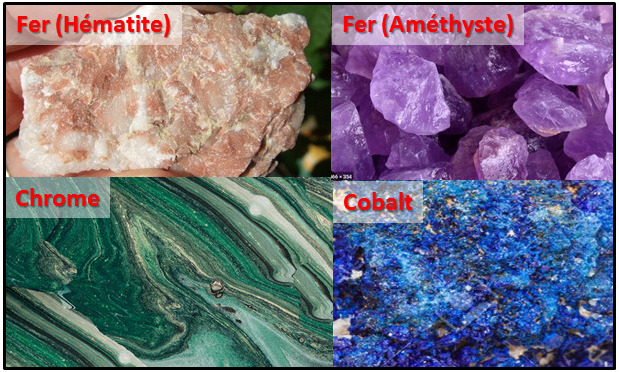
The lighthouse of Cape Béar or lighthouse of Béar is a pyramidal tower in exposed rocks with a height of 27 m, culminating at an altitude of 80 m above sea level.
Two different geological formations form the outer facings.
► Granite, a plutonic magmatic rock
~ Granite, a QFM rock
Granite comes from the slow crystallization in the earth's crust of liquid magma.
This results in a light colored QFM rock with a fully crystalline nature, a grainy texture (crystals visible to the naked eye) and a predominant chemical composition based on 3 minerals:
- Q for Quartz (SiO2): translucent sometimes transparent, this mineral is gray without facet.
- F for Feldspar: opaque to translucent, whitish or pink mineral (orthosis) depending on the presence of iron oxides and often twins (rectangular shape).
- M for Mica: this mineral is presented in fine shiny flakes in two forms:
- biotite, shiny black mica of ferromagnesian composition.
- muscovite, white mica shining in the sun with a pearly appearance.
~ The Xenoliths
A xenolith is an enclave of a rock included in a different rock.
Crustal acid magma rich in silica (light tint) gives granite sensu lato but this magma from the crust can tear off fragments of basic mantle magma (dark tint).
This gives pluri-centimetric enclaves within the granites, the xenoliths, which are characterized by a much darker color than the granite (rocks rich in ferromagnesium).
► The Villefranche de Conflent marble
In Villefranche de Conflent is the most characteristic marble of Roussillon.
Resulting from the metamorphization of Devonian sediments (-390 Ma), it is a crystalline rock made of calcite, hard, ungrained and with several facies.
~ Morello cherry facies
It is a purplish red marble with fossiliferous nodules. It is distinguished by its small stony concretions called "partridge eyes".
These eyes are the fossil remains of goniatites, ancestors of ammonites, in section like small red discs surrounded by a dark border reminiscent of morello cherries.
~ The "Sin flowers" facies
It is a nodular marble limestone without fossils.
Rather pale in tone, it is formed of versicolored, pink to white calcite almonds, which are partitioned by brown to greenish chlorite streaks.
~ The flamed facies
Installed on the Givétien floor, it is a pink or red marble limestone "flamed" or "flamed" with white, without trace of fossil.
~ Marble coloring
Initially white, calcite in marble can be colored by the presence of mineral impurities.
Here are some elements responsible for these colorations:
- Iron: at low concentration, it gives a purple color (amethyst), but in a more concentrated and oxidized form, gives a red / pink color to the crystal; we then speak of hematite.
- Chromium: it gives a green color to the mineral.
- Cobalt: it gives a blue color to the crystal.
► Sources bibliographiques / Bibliographical sources
Les Questions / The Questions
Questions pour valider :"Les Parements du Phare de Béar"
Questions to validate: "The facings of the Lighthouse of Béar"
- Question 0 : Prenez une photo de vous ou d'un élément vous appartenant avec le phare.
Cette photo devra au choix nous être transmise avec les réponses ou être ajoutée à votre log.
-Question 0 : Take a photo of yourself or something you own with the lighthouse.
This photo must either be sent to us with the answers or added to your log.
Depuis le chemin, approchez vous du petit mur extérieur du phare (photo WP1).
From the path, approach the small outer wall of the lighthouse (photo WP1).

- Question 1 : Sous la zone bleue A, décrivez la roche et déduisez-en sa nature. Comment s'appelle le minéral le plus sombre que nous pouvez-vous observer ?
- Question 1: Under blue area A, describe the rock and deduce its nature. What is the name of the darkest mineral that we can see?
- Question 2 : Qu'est-ce qui différencie les 3 zones vertes B de son encaissant. Comment s'appelle ces formations ?
- Question 2: What differentiates the 3 green zones B from its surrounding? What are these formations called?
- Question 3 : Décrivez les deux blocs jaunes C. De quel faciès du Marbre de Villefranche s'agit-il ?
- Question 3: Describe the two yellow blocks C. What facies of the Villefranche marble is it?
- Question 4 : Quelle minéral donne la coloration du bloc rouge D ?
- Question 4: Which mineral gives the color of the red block D?
Vous pouvez vous loguer sans attendre notre confirmation,
mais vous devez nous envoyer les réponses en même temps soit par mail via notre profil (
fafahakkai), soit via la messagerie geocaching.com (Message Center).
S'il y a des problèmes avec vos réponses nous vous en ferons part.
Les logs enregistrés sans réponse seront supprimés.
You can log this cache without waiting for our confirmation, but you must send us the answers at the same time, by e-mail via our profile (fafahakkai) or by the system of Message Center of geocaching.com.
If there is a problem with your answers we will notify you. The logs recorded without answers will be deleted.
Rappel concernant les « Earthcaches »: Il n'y a pas de conteneur à rechercher ni de logbook à renseigner. Il suffit de se rendre sur les lieux, de répondre aux questions ci-dessus et de nous renvoyer les réponses.
Reminder concerning "Earthcaches": there is neither a container to look for nor a logbook to sign. One need only go to the location, answer to the differents questions and send us the answers.